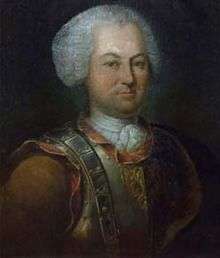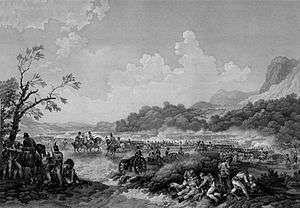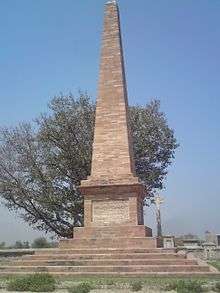61st (South Gloucestershire) Regiment of Foot
The 61st (South Gloucestershire) Regiment of Foot was an infantry regiment of the British Army, raised in 1756. Under the Childers Reforms it amalgamated with the 28th (North Gloucestershire) Regiment of Foot to form the Gloucestershire Regiment in 1881.
| 61st (South Gloucestershire) Regiment of Foot | |
|---|---|
| Active | 10 December 1756–1 July 1881 |
| Country | |
| Branch | |
| Type | Line Infantry |
| Garrison/HQ | Horfield Barracks, Bristol |
| Nickname(s) | The Silver Tailed Dandies, The Flowers of Toulouse[1] |
| Colors | Buff facings |
| March | The Highland Piper |
| Engagements | Seven Years' War Peninsular War Second Anglo-Sikh War Indian Rebellion of 1857 |
History
Formation

The formation of the regiment was prompted by the expansion of the army as a result of the commencement of the Seven Years' War. On 25 August 1756 it was ordered that a number of existing regiments should raise a second battalion; among those chosen was the 3rd Regiment of Foot. The 2nd Battalion of the 3rd Foot was formed on 10 December 1756. In September 1757 both battalions of the 3rd Foot took part in an assault of the French coast. They returned to England in October, and on 21 April 1758 the 2nd Battalion became the 61st Regiment of Foot, with Major General Granville Elliott as colonel. The new regiment retained the buff facings of the 3rd Foot.[2][3]
Early wars
In late 1758 the 61st Foot embarked for the West Indies. On 16 January 1759 they took part in the attempted Invasion of Martinique, but were forced to withdraw after three days. On 24 January they landed on Guadeloupe. Following more than three months of heavy fighting, the French forces surrendered on 1 May. The regiment returned to England in the summer of 1760 where they engaged in recruiting to make up for the casualties suffered in the West Indies.[4]
After a period of garrison service in England, Ireland and the Channel Islands the 61st Foot was stationed on the island of Menorca in 1771. The island had become a British possession under the Treaty of Paris of 1763. By 1779 Britain was involved in a war with America, France and Spain, and in August 1781 a Franco-Spanish force began an attack. The 61st found themselves besieged in Fort St Philip. By February 1782 the garrison's numbers had been greatly reduced by dysentery and they surrendered. The remains of the regiment were repatriated in May 1782 where they began recruiting.[2][5] In August 1782 all regiments of foot without a royal title were given a county designation, and the regiment became the 61st (South Gloucestershire) Regiment of Foot in 1782. In 1783 the regiment moved to Ireland where it remained until 1792. In the latter year they moved to Gibraltar.[2][6]
French Revolutionary and Napoleonic Wars

In 1793 the French Revolutionary government declared war on Great Britain. The 61st were once again dispatched to the Caribbean, landing in Martinique in December 1794. In April 1795 they moved to St Lucia as part of the force under Brigadier-General James Stewart. Forced to return to Martinique three months later, in the following year they returned to St Lucia as part of a successful invasion. The regiment had suffered very heavy casualties and returned to England in October 1796 to be made up to strength. They moved to Guernsey in 1797, and to the Cape of Good Hope in 1799.[2]
In 1801 the regiment proceeded to Egypt where they took part in the campaign to expel the French Armée d'Orient from the country.[7] In 1802 the regiment was awarded the badge of a sphinx superscribed "Egypt" for display on the regimental colours in commemoration of the campaign.[8]
In 1803 the regiment moved to Malta, and in July of the same year the existing regiment was redesignated as 1st Battalion, 61st (South Gloucestershire) Regiment of Foot when a second battalion was raised in County Durham and Northumberland. The 2nd Battalion was raised as part of the expansion of the army in response to the threat of invasion by France, and spent its entire existence in England and Ireland, before being disbanded in October 1814.[2][2][9]
In November the First Battalion (or 1/61st) landed in Italy. Early in the following year they were forced to evacuate to Sicily, along with the deposed King Ferdinand IV. The flank companies 1/61st returned to the Italian mainland in June 1806 as part of the force commanded by Major-General John Stuart, and took part in the Battle of Maida on 4 July. The battalion returned to Sicily soon after. In 1807 they moved to Gibraltar.[2][10]
In June 1809 the 1/61st landed in Lisbon, Portugal and joined the army fighting under Sir Arthur Wellesley in Spain. They took part in the Battle of Talavera on 27–28 July. The 1st Battalion, which had seen heavy casualties, received a draft of 300 men from the 2nd Battalion in February 1810, bringing up to full strength.[2][11] They saw action in a number of minor engagements taking part in the Battle of Salamanca (22 July 1812) and the Siege of Burgos (September - October 1812), the Battle of the Pyrenees (July - August 1813). They pursued the retreating French forces into France, fighting at the Battle of Nivelle (November 1813), Battle of the Nive (December 1813), Battle of Orthez (February 1814) and the Battle of Toulouse in April 1814. The battalion's commanding officer, Lieutenant-Colonel Robert John Coghlan was killed at Toulouse.[2] Within a few days French forces had capitulated and the 1/61st was moved to Bordeaux.[12]
The 1st Battalion landed in Cork, Ireland in July 1814, proceeding to Dundalk where it absorbed the abolished 2nd Battalion in October.[2]
The Victorian era

The 61st Foot spent more than thirty years on garrison duty before seeing active service again. From 1816-22 they were stationed in Jamaica, from 1822-28 in England and from 1828-40 in Ceylon. They were stationed in England and Ireland from 1840-45.[2] In 1845 they moved to India, fighting in the Second Anglo-Sikh War of 1848-49: at the Battle of Ramnagar (November 1848), Battles of Saddalupar and Chillianwala (December 1848-January 1849) and Battle of Gujrat (February 1849).[2] The regiment was still in India when Indian Rebellion of 1857 broke out. They took part in the Siege of Delhi.[2]
The remaining years of the 61st's existence as a separate regiment were uneventful. From India they moved to Mauritius in 1859 for a year before returning to England. Following garrison duty in the Channel Islands and Ireland, they moved to Bermuda in 1866 and Canada in 1870.[2] In 1872 they moved to Ireland. In 1873, under the Cardwell Reforms, the United Kingdom was divided into 66 "Brigade Districts" which generally corresponded to one or more counties. A depot was to be established, which would be the home for two regular infantry battalions. At any one time one of the regular battalions was to be on "home" service and the other on "foreign" duty, with the roles being rotated from time to time. The county militia regiments were also to share the depots. The 61st Foot were linked with the 28th (North Gloucestershire) Regiment of Foot and assigned to district no. 37 at Horfield Barracks in Bristol.[13][14] The 61st subsequently moved to the Channel Islands in 1875, England in 1876 and Malta in 1878. In 1880 they returned to India.[2] On 1 July 1881 the Childers Reforms came into effect and the 28th and 61st Regiments along with the militia regiments of Gloucestershire were amalgamated to form the Gloucestershire Regiment. The 61st Foot became 2nd Battalion, The Gloucestershire Regiment.[15] Following two further amalgamations, the regiment's lineage is continued today by The Rifles.[16]
Battle honours
The 61st Foot were awarded the following battle honours for display on the regimental colours. (In some cases the spelling differs from the modern form):[8]
|
|
Victoria Crosses
Herbert Taylor Reade was awarded the Victoria Cross for actions during the Indian Mutiny.
Colonels of the Regiment
Colonels of the Regiment were:[8]
- 1742–1743: Maj-Gen. Edward Richbell
- 1743–1747: Lt-Gen. John Folliott
- 1747–1748: Lt-Gen. Edward Pole
- Regiment disbanded 1748
61st Regiment of Foot - (1758)
- 1758–1759: Maj-Gen. Granville Elliott
- 1759–1768: Lt-Gen. Sir George Gray, 3rd Baronet
- 1768–1773: Lt-Gen. John Gore
- 1773–1778: Maj-Gen. John Barlow
- 1778–1800: Gen. Staats Long Morris
61st (the South Gloucestershire) Regiment of Foot - (1782)
- 1800–1840: Gen. Sir George Hewett, 1st Baronet, GCB
- 1840–1844: Lt-Gen. Sir John Gardiner, KCB
- 1844–1848: Lt-Gen. Sir Jeremiah Dickson, KCB
- 1848: Lt-Gen. George Guy Carleton L'Estrange, CB
- 1848–1852: Gen. Hastings Fraser, CB
- 1852–1864: Gen. John Reeve
- 1864–1870: Lt-Gen. Edward Hungerford Delaval Elers Napier
- 1870–1874: Gen. Sir Horatio Shirley, KCB
- 1874–1881: Gen. Sir Thomas Montagu Steele, GCB
References
- Swinson, Arthur (1972). A Register of the Regiments and Corps of the British Army. London: The Archive Press. p. 161. ISBN 0-85591-000-3.
- Mills, T F. "1st Battalion, 61st Regiment of Foot". Regiments.org. Archived from the original on 21 December 2007. Retrieved 6 January 2013.
- Cannon (1844) p.9
- Cannon (1844) pp.10-12
- Cannon (1844) pp.12-15
- Cannon (1844) pp.13-14
- Cannon (1844) pp.15-17
- Mills, T F. "61st (South Gloucestershire) Regiment of Foot". Regiments.org. Archived from the original on 14 December 2007. Retrieved 7 January 2013.
- Cannon (1844) pp.18-19
- Cannon (1844) pp.21-23
- Cannon (1844) pp.24-25
- Cannon (1844) pp.30-42
- "Training Depots". Regiments.org. Archived from the original on 10 February 2006. Retrieved 16 October 2016.CS1 maint: BOT: original-url status unknown (link)
- "The Army Localisation Scheme". The Morning Post. 12 February 1873. p. 3.
- "No. 24992". The London Gazette. 1 July 1881. pp. 3300–3301.
- "2007 - Formation of The Rifles". Soldiers of Gloucestershire Museum. Archived from the original on 8 March 2013. Retrieved 10 January 2013.
- Sumner (2001), p.27
- Sumner (2001), p.28
Sources
- Cannon, Richard (1844). Historical Record of the Sixty-First, or the South Gloucestershire Regiment of Foot. London: Parker, Furnivall and Parker.
- Sumner, Ian (2001). British Colours & Standards 1747-1881 (2) Infantry. Oxford: Osprey Publishing. ISBN 1841762016.